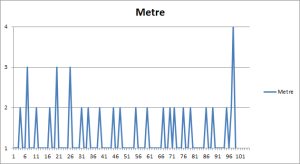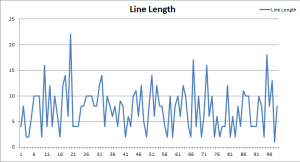A lot of what I do for my research is looking into how Martial’s books are structured, looking to argue that you can indeed actually read a book of epigrams as a sequential book, and that the authorial persona encourages you to do so. Whenever I tell people that I’m examining the structure of books of epigrams, though, their eyes tend to glaze over. I get it – structure isn’t a particularly exciting sounding subject, and at times it can be a bit boring… But today, I wanted to spend a little bit of time looking at Martial “by the numbers” (as my blogpost title suggests) to try and show you how structure and numerical approaches to a text can be interesting, or at least furnish some interesting results.
I’m going to share two things with you: firstly, a couple of graphs I’ve mocked up for my own personal understanding of Epigrams 7 (the specific book most of my thesis has focused upon) showing how Martial structures by variation in a diagrammatic manner. Secondly (something I recently spent most of the morning doing), a brief exploration of the booklengths of Martial’s books, and what sort of questions these numbers throw up and/or answer.
So, without much further ado:
Book 7 – Metrical Variation & Poem Line Lengths
Martial is a poet typified by his variatio (variety in English) – he throws a medley of different themes together to create a riot of different associations and juxtapositions. The result is dizzying at times (check out Fitzgerald 2007 on this), but can also be quite pleasing – the sexual depravities (as Martial sees them) of the women Philaenis at 7.67 & 7.70 form a brief frame around a couple of poems on Romans of outstanding morality. After reading these four poems in sequence, however, we might ask ourselves how upright the subjects of 7.68 & 7.69 actually are in the bedroom…
Variatio is a strong feature of light verse, or nugae as the poets had been saying since at least Catullus, and Martial at one point tells the emperor Domitian (tongue-in-cheek?) that
I have indeed tried to vary [my subject matter] through the mixture of jokes, lest every verse should heap up its own praise for your celestial reverence, which could tire you more easily than it would sate us. (8.praef.8-11)
Variation of subject matter, then. But subject matter is not the only kind of variety going on in Martial, and if you look at the Latin you can easily tell that the structure of his poems is different. Martial uses a variety of different metres (most commonly the elegiac couplet, the hendecasyllable, and the scazon – also known as choliambics), and not only do they look different (the second line of the elegiac couplet is slightly indented) they also sounded different. Roman poetry worked through stressing long and short syllables, and certain metres had different associations. (Llewelyn Morgan’s Musa Pedestris book is brilliant on this, by the way.) So not only does Martial’s poetry discuss different things, it also sounds different and evokes a variety of different connotations (scazons, for instance, are often involved with invective humour).
So let’s take a quick look at how Martial spreads out his different metres across book 7:
The file’s come out a bit small (you should be able to enlarge the graph by clicking on it), but you’ll be able to see the variation at work. I gave each metre in book 7 a number, and then plotted the points. The bottom (y) axis is the progression of poems in the book, the side (x) axis plots the metres. These are: 1 Elegiac couplets; 2 hendecasyllables; 3 scazon; and 4 hexameter (there is one single poem of a single hexameter line in the book). Scazonic verse appears the most at the start of the book (getting the ruder poems out of the way faster?), and hendecasyllables punctuate the general flow of elegiac couplets. The hexameter poem precedes the end of the book with a bang.What comes across is that Martial varies up his metre to evoke a different sound and general ‘feel’ (I guess the academic term would be “mood”) as his work progresses.
So far so good. Let’s look at poem line lengths in book 7:
This time the y axis continues to be the progression of poems, but the x axis is each poem’s number of lines. Interestingly, this graph is much more jagged – variation is taking place on a more frequent basis. Indeed, in general Martial seems to juxtapose a long poem with a short one, perhaps giving the reader a chance to rest as they continue through the text. If a book was full of really long poems we’d be more likely to put it down. Is Martial trying to egg his reader on all the way through? He certainly wants his reader to read him all the way through in his second preface (this could easily be another blog post in itself). Once again we see variety in Martial, but not the sort of variety that most people analyse – scholars are generally more interested in thematic interplay (as am I, to be fair). What this analysis here offers, however, is a look at the overall architecture of the book.
Still reading? Let’s move onto a broader overview of the corpus.
Book Lengths
Scholarship on Latin poetry and the ancient book has traditionally focused on the book length. In the Augustan period (usually seen as the “Golden Age” of Latin poetry, which sidelines great authors like Martial to the dustbin of the “Silver Latin” age) a ‘good’ poetry book would not be much longer than 800-1000 lines. If a book doesn’t follow this scheme, or doesn’t display the same structure as Vergil’s Georgics, it is often deemed un-Augustan and thus ‘bad’.
I may have a bit of a bee in my bonnet, but it seems odd to judge works by their overall length. What is more interesting to me, however, is whether or not each book of Martial would have been written out on its own individual scroll. Be warned, reader – a lot of this discussion gets a bit ethereal and speculative. Van Sickle set the bar quite high in the 1980s, at the length of 1000-2000 lines per papyrus scroll of Homer. Each scroll could theoretically continue multiple individual ‘books’ of a work (‘book’ referring to a significant section of an individual work, a bit like ‘chapters’ today but longer).
Where would this leave Martial? Let’s have a quick look at book lengths of Martial (counted up more-or-less by hand by me, so apologies for any minor inaccuracies). Caveat: these lengths do not include prose prefaces with their prefatory epigrams, which precede books 1, 2, 8, 9, and 12.
- Book 1: 821 lines
- Book 2: 546 lines
- Book 3: 644 lines
- Book 4: 670 lines
- Book 5: 645 lines
- Book 6: 615 lines
- Book 7: 737 lines
- Book 8: 661 lines
- Book 9: 910 lines
- Book 10: 898 lines
- Book 11*: 809 lines
- Book 12*: 719 lines
*: Books 11 and 12 both have one poem that is slightly lacunose (i.e. missing lines), so their original length would have been a bit longer.
Alright. First observations: Book 2 is the shortest book at 546 lines, and book 9 at the lengthiest (910+ preface with its own 8-line epigram). In general I’d say that Martial’s ‘standard’ book would have been c. 650-700 lines long. Multiple books could fit on a single papyrus scroll relatively easily (perhaps paired up?) if we follow Van Sickle.
I would like to note, however, that the production of papyri in the ancient world effectively amounted to pasting sheets of papyrus together and then rolling them up, so any book length would theoretically have been possible. Martial frequently refers to his work as libelli (little books) rather than libri (books). While this is a part of his self-deprecation in writing light verse (nugae), this could also reflect the reality that his libelli were shorter papyrus rolls that the libri.
Moving away from speculative analysis, however, it is interesting that book 2 is so short. Arguments for this have been made that the book was a release soon after or alongside book 1, and so book 2 held the ‘overflow’ of extra poems (see Sullivan on this). This may have been the case, but my interest is piqued by the nature of book 2 itself. This book is (more than any other of Martial’s books) rather obsessed with its own length. The prefatory letter and first poem of the book both refer to its size. Here’s a brief extract of 2.1:
Indeed you could bear three hundred epigrams,
My book, but who would bear and read you through (perlegeret)?
[8 more lines]
You consider yourself safe with so much brevity?
Ah me, how long you’ll be to many anyway!
Martial says that his reader should read him all the way through (perlegeret) because the book is so small (the bit I didn’t include says that this libellus is shorter and better for it than a liber), ending on the worry that even though the book is so brief it’ll be considered long at any rate. Given that this is the shortest book of the corpus, could we see a bit of playfulness here? The shortest book of the corpus states its brevity, but chastises the reader who thinks it’s too small. Paying attention to numbers can add some extra nuance to our understanding of the book.
Indeed, the longest book is book 9 – a work obsessed with monuments and fame. This is the last book before Domitian is assassinated, and (perhaps too) fittingly forms the peak of a crescendo of panegyric that began in book 7. What could be more fitting than having the book that exults in the poet’s highest point of literary success also be his longest?
I’m sure there are more observations that I could make about length in Martial (perhaps I’ll write a paper on it someday), but for now I think we can say that by paying attention to the parts of the book that we don’t normally ‘read’ – the length, the variation of metre – we spot some interesting features of Martial’s Epigrams.
Bibliography
Fitzgerald, W. (2007) Martial: The World of the Epigram, Chicago & London.
Morgan, L. (2010) Musa Pedestris: Metre and Meaning in Roman Verse, Oxford.
Van Sickle, J. (1980) ‘The Book-Roll and Some Conventions of the Poetic Book’ Arethusa 13, 5-42.
Further Reading
I cannot recommend enough William Johnson’s 2010 magnum opus “Readers and Reading Culture in the High Roman Empire”, which gives a stellar reconstruction of the ancient book roll (p.17ff.) and a careful reading of ancient literary culture in general.


